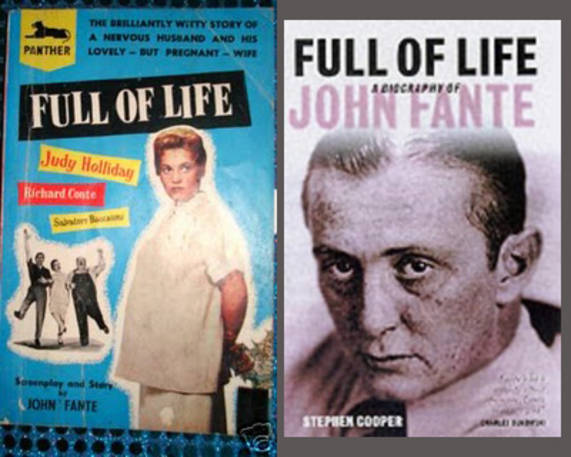


“He’s a stonesmen, he hates stucco.”
~~Nick Rocco, in speaking about his father
Richard Conte may be more famous for playing Don Barzini (from “After all, we are not communists,” fame in The Godfather), but it’s as Nick Rocco, in Richard Quine’s Full of Life, that he most astutely captures some of the complexities of an Italian American identity.
In the rather obscure 1956 film, based on the novel (and screenplay) by John Fante, Conte plays a veiled Fante character: a young, married, struggling writer, living off an advance with his pregnant wife, Emily (played by Judy Holliday) in postwar suburban Glendale, California.
The film was marketed as a light-hearted romantic comedy but it struck me as much more serious than that because of the way it concludes with a reaffirmation of certain traditional Italian American (Catholic, in fact) values. Stephen Cooper in his biography of Fante, also entitled Full of Life, remarks on how the “shrewdly orchestrated publicity campaign prepared the nation for Full of Life” (255). For instance, Macy’s Department Store created a series of tie-ins connected to Judy Holliday’s character, an expectant first-time mother; the store’s advertising campaign included a line that rings out-of-place, in the sterile, anti-breastfeeding, 1950s America: Full of Life “rates an extra round of cheers for treating pregnancy as naturally as….a walk in the country” (255).

Indeed, the film’s wholesomeness is vividly apparent in the broad slapstick comedy it favors. And yet, I didn’t even crack a smile until well over an hour into the film. My amusement came from seeing something that was so exaggerated and simultaneously something I knew to be authentically (a slippery word, I’m aware) plausible. While the classic scene of the eight months pregnant, independent-thinking, Emily falling through her kitchen floor was certainly meant to have audiences in stitches, it was the hardcore ethnic references that got me chuckling.

In fact, it is in such ethnic comedic sketches that we witness Fante’s creation of a non-typecast, Italian American identity, placing it squarely in a California setting. To cut to the chase, Fante and Quine (although based on Fante’s novel, the two worked closely on the script and mine is a cinematic, not literary analysis) complicate Italian American filmic representation by capturing—in a touching and real-to-life way—images of West Coast Italians. It’s a particular combination of identity and location that Hollywood, still today, has yet to mine for clichés.
As such, ethnic- generational clash jokes (i.e., Nick’s father brings a suitcase full of wine and food on the train from Sacramento to Los Angeles, embarrassing his grown son) move beyond stock Hollywood gags because they are placed far outside of the standard locations where those clichés are usually found. This may seem like a simplified argument, but take a moment to consider the character of Nick’s father, Papa Vittorio Rocco, played by operatic bass, Salvatore Baccaloni.
We meet Papa Rocco on his Sacramento Valley land (a spot that is practically a spitting image of Litto Damonte’s Hubcap Ranch [2] , minus the chrome). Pre-dating Don Corleone’s more famous moment with a feline, he sits with a kitten on his lap, talking of lemon trees, grape vines, and the magical qualities of garlic.
In his actions and words he (not to mention his wife, played by Esther Miniciotti) is in many ways a stereotyped Italian immigrant, and yet he is likewise shaped by the unusualness of his persona. Fante, mightily aware of himself-as-author in this film (Cooper notes that Nick quotes a line from Fante’s Ask the Dust at one point in the movie) works hard to call attention to the Rocco family’s Italianness, because without it the slapstick humor could not carry the film’s weighty conclusion.

The film’s most exaggerated ethnic joke comes when Papa Rocco purposely destroys the young couple’s fireplace and builds an immense stone one in its place. He rips out an entire stucco wall—the standard material for California’s ranch houses—and replaces it with an intricate stone one. He constructs an absurdly beautiful and inspired structure, expressing an Italian American sense of place, one that leads the Dianetics-reading Emily to a kind of cultural appropriation of Italian Americana.
That Papa Rocco’s construction is tied to California mid-century architecture (stucco and ranch houses) and to his immigrant working-class identity (a stone mason who never stops working), suggests a slew of possibilities about the ways Italian American identity has been shaped with and against other identities and experiences. Moreover, it reminds us of the relevance of recognizing regionally-specific representations of ethnic identity—with the recent onslaught of New Jersey-flavored Italian American pop culture, such a lesson has arrived not a moment too soon.
Source URL: http://test.iitaly.org/magazine/focus/life-people/article/hollywood-italian-americans-and-golden-coast
Links
[1] http://test.iitaly.org/files/ruberto1280680087jpg
[2] http://www.i-italy.org/bloggers/1605/italian-americana-california-style